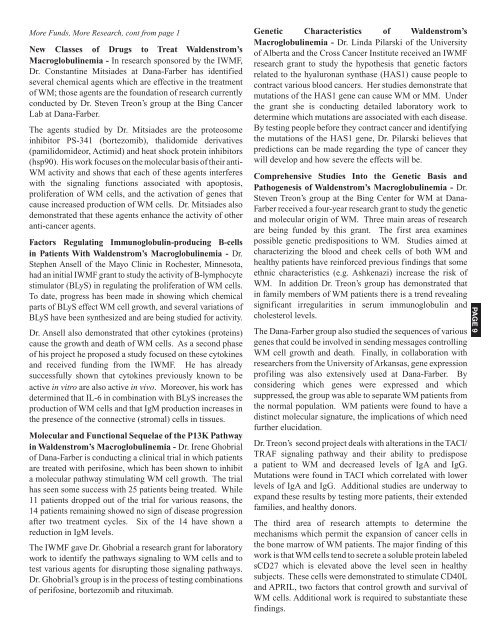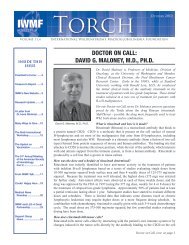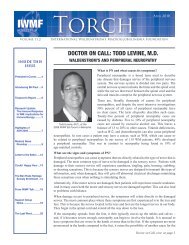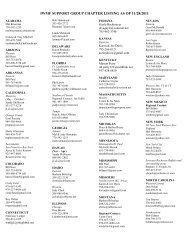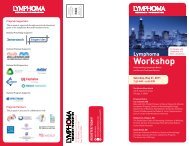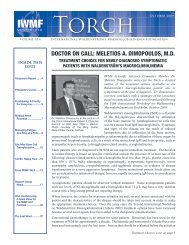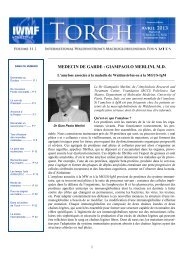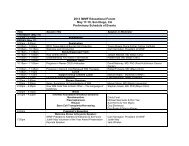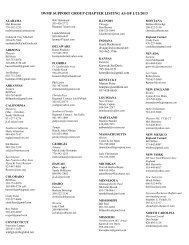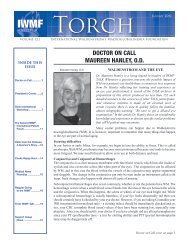Fall 2007 - International Waldenstrom's Macroglobulinemia ...
Fall 2007 - International Waldenstrom's Macroglobulinemia ...
Fall 2007 - International Waldenstrom's Macroglobulinemia ...
Create successful ePaper yourself
Turn your PDF publications into a flip-book with our unique Google optimized e-Paper software.
More Funds, More Research, cont from page 1<br />
New Classes of Drugs to Treat Waldenstrom’s<br />
<strong>Macroglobulinemia</strong> - In research sponsored by the IWMF,<br />
Dr. Constantine Mitsiades at Dana-Farber has identified<br />
several chemical agents which are effective in the treatment<br />
of WM; those agents are the foundation of research currently<br />
conducted by Dr. Steven Treon’s group at the Bing Cancer<br />
Lab at Dana-Farber.<br />
The agents studied by Dr. Mitsiades are the proteosome<br />
inhibitor PS-341 (bortezomib), thalidomide derivatives<br />
(pamilidomideor, Actimid) and heat shock protein inhibitors<br />
(hsp90). His work focuses on the molecular basis of their anti-<br />
WM activity and shows that each of these agents interferes<br />
with the signaling functions associated with apoptosis,<br />
proliferation of WM cells, and the activation of genes that<br />
cause increased production of WM cells. Dr. Mitsiades also<br />
demonstrated that these agents enhance the activity of other<br />
anti-cancer agents.<br />
Factors Regulating Immunoglobulin-producing B-cells<br />
in Patients With Waldenstrom’s <strong>Macroglobulinemia</strong> - Dr.<br />
Stephen Ansell of the Mayo Clinic in Rochester, Minnesota,<br />
had an initial IWMF grant to study the activity of B-lymphocyte<br />
stimulator (BLyS) in regulating the proliferation of WM cells.<br />
To date, progress has been made in showing which chemical<br />
parts of BLyS effect WM cell growth, and several variations of<br />
BLyS have been synthesized and are being studied for activity.<br />
Dr. Ansell also demonstrated that other cytokines (proteins)<br />
cause the growth and death of WM cells. As a second phase<br />
of his project he proposed a study focused on these cytokines<br />
and received funding from the IWMF. He has already<br />
successfully shown that cytokines previously known to be<br />
active in vitro are also active in vivo. Moreover, his work has<br />
determined that IL-6 in combination with BLyS increases the<br />
production of WM cells and that IgM production increases in<br />
the presence of the connective (stromal) cells in tissues.<br />
Molecular and Functional Sequelae of the P13K Pathway<br />
in Waldenstrom’s <strong>Macroglobulinemia</strong> - Dr. Irene Ghobrial<br />
of Dana-Farber is conducting a clinical trial in which patients<br />
are treated with perifosine, which has been shown to inhibit<br />
a molecular pathway stimulating WM cell growth. The trial<br />
has seen some success with 25 patients being treated. While<br />
11 patients dropped out of the trial for various reasons, the<br />
14 patients remaining showed no sign of disease progression<br />
after two treatment cycles. Six of the 14 have shown a<br />
reduction in IgM levels.<br />
The IWMF gave Dr. Ghobrial a research grant for laboratory<br />
work to identify the pathways signaling to WM cells and to<br />
test various agents for disrupting those signaling pathways.<br />
Dr. Ghobrial’s group is in the process of testing combinations<br />
of perifosine, bortezomib and rituximab.<br />
Genetic Characteristics of Waldenstrom’s<br />
<strong>Macroglobulinemia</strong> - Dr. Linda Pilarski of the University<br />
of Alberta and the Cross Cancer Institute received an IWMF<br />
research grant to study the hypothesis that genetic factors<br />
related to the hyaluronan synthase (HAS1) cause people to<br />
contract various blood cancers. Her studies demonstrate that<br />
mutations of the HAS1 gene can cause WM or MM. Under<br />
the grant she is conducting detailed laboratory work to<br />
determine which mutations are associated with each disease.<br />
By testing people before they contract cancer and identifying<br />
the mutations of the HAS1 gene, Dr. Pilarski believes that<br />
predictions can be made regarding the type of cancer they<br />
will develop and how severe the effects will be.<br />
Comprehensive Studies Into the Genetic Basis and<br />
Pathogenesis of Waldenstrom’s <strong>Macroglobulinemia</strong> - Dr.<br />
Steven Treon’s group at the Bing Center for WM at Dana-<br />
Farber received a four-year research grant to study the genetic<br />
and molecular origin of WM. Three main areas of research<br />
are being funded by this grant. The first area examines<br />
possible genetic predispositions to WM. Studies aimed at<br />
characterizing the blood and cheek cells of both WM and<br />
healthy patients have reinforced previous findings that some<br />
ethnic characteristics (e.g. Ashkenazi) increase the risk of<br />
WM. In addition Dr. Treon’s group has demonstrated that<br />
in family members of WM patients there is a trend revealing<br />
significant irregularities in serum immunoglobulin and<br />
cholesterol levels.<br />
The Dana-Farber group also studied the sequences of various<br />
genes that could be involved in sending messages controlling<br />
WM cell growth and death. Finally, in collaboration with<br />
researchers from the University of Arkansas, gene expression<br />
profiling was also extensively used at Dana-Farber. By<br />
considering which genes were expressed and which<br />
suppressed, the group was able to separate WM patients from<br />
the normal population. WM patients were found to have a<br />
distinct molecular signature, the implications of which need<br />
further elucidation.<br />
Dr. Treon’s second project deals with alterations in the TACI/<br />
TRAF signaling pathway and their ability to predispose<br />
a patient to WM and decreased levels of IgA and IgG.<br />
Mutations were found in TACI which correlated with lower<br />
levels of IgA and IgG. Additional studies are underway to<br />
expand these results by testing more patients, their extended<br />
families, and healthy donors.<br />
The third area of research attempts to determine the<br />
mechanisms which permit the expansion of cancer cells in<br />
the bone marrow of WM patients. The major finding of this<br />
work is that WM cells tend to secrete a soluble protein labeled<br />
sCD27 which is elevated above the level seen in healthy<br />
subjects. These cells were demonstrated to stimulate CD40L<br />
and APRIL, two factors that control growth and survival of<br />
WM cells. Additional work is required to substantiate these<br />
findings.<br />
PAGE 9


